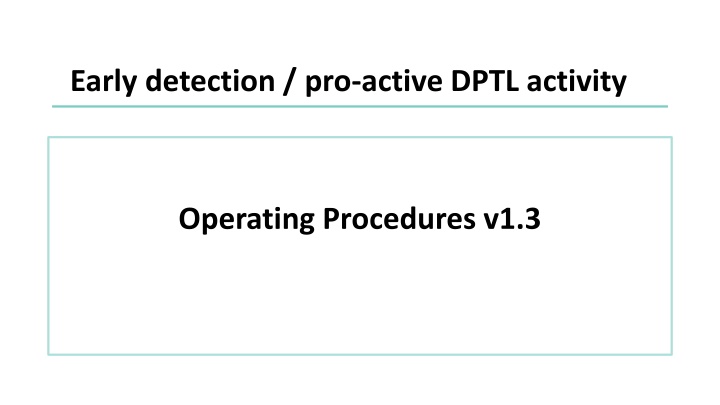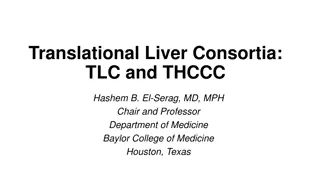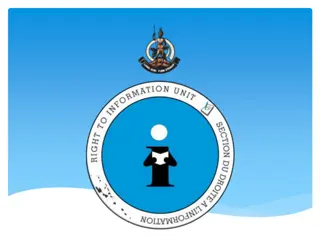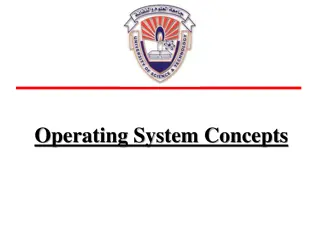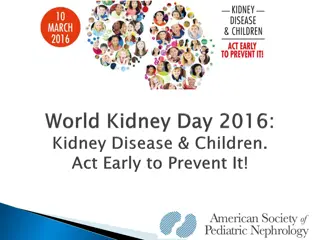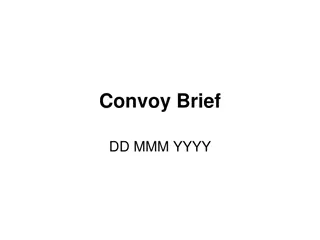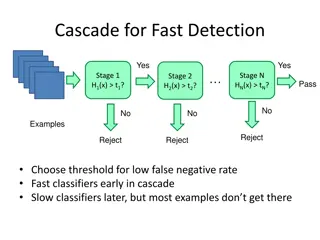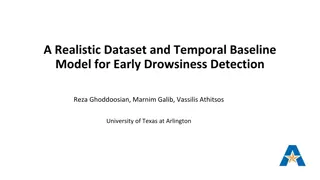Early Detection and Proactive DPTL Activity Operating Procedures
Coordinated multi-disciplinary team efforts are crucial in preparing patients for discharge promptly to avoid prolonged hospital stays. Early detection and proactive DPTL activity focus on identifying potential discharge obstacles as soon as patients arrive in the emergency department. Various common discharge blockers need to be addressed swiftly to streamline the discharge process. A range of specialized teams and professionals contribute to facilitating efficient discharge planning and execution.
Download Presentation

Please find below an Image/Link to download the presentation.
The content on the website is provided AS IS for your information and personal use only. It may not be sold, licensed, or shared on other websites without obtaining consent from the author.If you encounter any issues during the download, it is possible that the publisher has removed the file from their server.
You are allowed to download the files provided on this website for personal or commercial use, subject to the condition that they are used lawfully. All files are the property of their respective owners.
The content on the website is provided AS IS for your information and personal use only. It may not be sold, licensed, or shared on other websites without obtaining consent from the author.
E N D
Presentation Transcript
Early detection / pro-active DPTL activity Operating Procedures v1.3
What is early detection / pro-active DPTL activity? Coordinated MDT input to prepare patients for discharge as soon as they are MFFD is vital, to avoid extended lengths of stay. This work is undertaken by system partners in the pre-Hub (pre-discharge) space. A Discharge Patient Tracker List (DPTL) is compiled once a week by Bart s Health staff. This provides a snap-shot of bed occupancy each week, and lists every patient who is occupying a hospital bed. Early detection or pro-active DPTL activity adds value to D2A discharge planning because a patient s length of stay can be extended by factors other than clinical need, and these need to be identified speedily. Early detection focuses on identifying potential discharge blockers as soon as the patient arrives in ED. The impact of early detection may be small in some instances, but is still significant. A length of stay reduction of just 1 day or less is still a mark of success and should be prioritised (and celebrated).
Common discharge blockers Patient lives alone may need a keysafe Patient is prone to falls may need telecare Patient cannot manage stairs may need a micro-environment Patient is a hoarder accommodation may need de-cluttering Patient lives with family who are challenging may need support with complex family dynamics Patient has a partner who is refusing to have them home management of expectations may be required Patient lives in accommodation that is unsuitable following an acute episode (eg: a stroke) rehousing options need to be explored Patient is under 65 or presents with challenging behaviour and needs 24hr care early discharge planning with Brokerage is essential Patient is potentially or actually homeless a DTR alert and follow up via the Housing Services homelessness coordinator are required Patient is thought to be a victim of abuse formal safeguarding follow up may be warranted (Peace ward) Patient has had a stroke and will need timely discharge planning before their inpatient rehab ends especially if safeguarding concerns about care provision have been raised
Contributing teams Pre-admission areas (ED, AAU, FAU) Pit Stop therapy staff (Gemma Stanley-Davies Senior Therapy Lead) Admission Avoidance Team (Maria Pitt Head of Nursing Medicine and Older People s Services) Complex Discharge Team (Paul Hooper Patient Flow Coordinator, supported by Ash Halkhoree) Adult Social Care - Social worker from the Hub Active Recovery Team (HART Sharon Samain) Age UK (Kate Angus) Housing Services Hospital Discharge Coordinator (Sandra King) Admission wards OTs and PTs (Viv Tan) Complex Discharge Team (Ash Halkhoree) Adult Social Care social workers from HART (Natalie Carey Senior Practitioner) Age UK (Kate Angus) Housing Services Hospital Discharge Coordinator (Sandra King)
Operational enablers Contact list for each team Mosaic login access for CDT staff (Paul Hooper & Sylvania Godfrey) and Admission Avoidance Team staff Cerner access for ASC staff in HART Bleep for social worker covering ED. Mobile phone liaison between staff in CDT, acute therapy and HART Physical presence of HART SWs in the CDT office Clarity about the remit of Age UK SW attendance at weekly board meetings on Peace Ward required because early discharge planning with stroke survivors is essential Once weekly early detection / pro-active DPTL huddles between Ash / CDT, Sharon / HART and Gemma, to agree actions required to facilitate discharges for patients where the risk of an extended length of stay due to discharge blockers has been identified
Roles and responsibilities pre-admission areas Early detection of potential discharge blockers should start as soon as the patient arrives in ED. Participating staff should use the aide memoire on slide 9 to help guide their structured conversation with the patient, to identify factors that may extend their length of stay. Any member of the MDT can undertake early detection activity. Discharge blockers that can be removed by provision of simple practical support (eg: moving furniture) should be referred within 2hrs to Kate Angus at Age UK. More complex discharge blockers that link to a plan to meet Care Act eligible needs should be raised with ASC/HART within 2hrs by e-mailing WXUHsocialworkteam@walthamforest.gov.uk. Tasks will be assigned from there to an early detection / pro-active DPTL SW - Perminder Bhogal or Julius Oladapo, or Nana Nuamah-Kutin (duty SW) in their absence. Preventing an avoidable admission for the patient in ED is paramount. Therefore, requests for support to remove discharge blockers warrant an urgent response within 2hrs, and must be prioritised.
Roles and responsibilities wards Early detection of potential discharge blockers should start as soon as the patient arrives on the ward. Early detection is led by the patient flow coordinators / case managers in CDT. CDT staff can use the aide memoire on slide 9 to help guide their structured conversation with the patient, to identify factors that may extend their length of stay. Discharge blockers that can be removed by provision of simple practical support (eg: moving furniture) should be referred within 2hrs to Kate Angus at Age UK. More complex discharge blockers that link to a plan to meet Care Act eligible needs should be raised with ASC/HART within 2hrs by e-mailing WXUHsocialworkteam@walthamforest.gov.uk Tasks will be assigned from there to an early detection / pro-active DPTL SW - Perminder Bhogal or Julius Oladapo, or Nana Nuamah-Kutin (duty SW) in their absence. CDT staff can also speak to Perminder and/or Julius in the CDT team room (after sending a request to the generic e-mail in-box), and if Perminder or Julius have capacity they will assist straight away. Preventing an extended length of stay for the patient on a ward is paramount. Therefore, requests for support to remove discharge blockers warrant a same day response and must be prioritised.
Escalation process Pre-admission areas If a referral is made to ASC/HART for a discharge blocker to be addressed and this is not responded to within 2hrs, the referrer should e-mail Sharon.Samain@walthamforest.gov.uk (HART TM) If there is no response by close of business that day, the referrer should e-mail Michael.Kite@walthamforest.gov.uk(Interim Head of Service) Admission wards If a referral is made to ASC/HART for a discharge blocker to be addressed and this is not responded to by close of business that day, the referrer should e-mail Sharon.Samain@walthamforest.gov.uk If there is no response by close of business the following day, the referrer should e-mail Michael.Kite@walthamforest.gov.uk
Aide memoire for interviewing patients on arrival (ED or ward) Does the patient have the mental capacity to make informed decisions about their care and support needs? Does the patient have potential to be re-abled? If they are on Peace ward, early discharge planning is vital. Has an OT/PT assessment been completed where appropriate? Does the person have an existing care package in place? If so, is this ASC-funded or self-funded? Does the patient need equipment for them to be discharged safely? If yes, who is ordering it? Has a delivery date been confirmed? Does the patient need a community alarm or telecare? Is a keysafe required? Is a keysafe in situ? If so, has the code been recorded? Is a system for management of medication in place? Does the patient need furniture to be moved at home, or do they require a micro-environment? Is the patient s home environment cluttered? Are their safeguarding concerns that could extend the patient s length of stay? Are there complex family dynamics that need to be addressed? Is the patient potentially or actually homeless? Does the patient have recourse to public funds? If not, is their Home Office status known? Any other concerns?
Use of the DPTL spreadsheet maximising the impact of early detection The DPTL list should be filtered by an ASC/HART manager on the day when it is circulated by CDT. Filtering should focus on identifying patients who are most likely to benefit from early detection research that will reduce their length of stay. Patients should be prioritised in the following order: Patients aged 75+ on pathway 1 (for interim care / Reablement at home) Patients aged 65+ on pathway 1 Patients aged 50+ on pathway 1 Patients of all ages on pathway 2 (for interim care / Rehabilitative support in a bedded setting) Discharge blockers that can be removed by provision of simple practical support (eg: moving furniture) should be referred within 2hrs to Kate Angus at Age UK. More complex discharge blockers that link to a plan to meet Care Act eligible needs should be raised with ASC/HART within 2hrs by e-mailing WXUHsocialworkteam@walthamforest.gov.uk Tasks will be assigned from there to an early detection / pro-active DPTL SW - Perminder Bhogal or Julius Oladapo, or Nana Nuamah-Kutin (duty SW) in their absence.
Early detection collaboration between CDT, HART (Hub Active Recovery Team) and the acute therapy service Therapy (OT/PT) reviews: All patients open to an OT or PT who have been in hospital for more than 5 days and who have not yet been referred to IDH will be reviewed by a senior (band 7+) therapist, to ensure that the discharge plan is progressing and to identify potential discharge blockers. This process will involve: A review of relevant documentation A discussion with the allocated therapist A joint session with the patient and the allocated therapist if that is required Weekly 50 minute huddles: Sharon, Ash and Gemma Stanley-Davies will meet once weekly for 50 minutes to discuss more complex patients where the risk of an extended length of stay due to discharge blockers has been identified. In these cases, co-ordinated support will be provided jointly by staff in the pre-Hub space, led by the patient flow coordinator / case manager in CDT. To avoid duplication of effort and any risk of mis-communication, CDT staff will update IDH once the patient is medically fit to be discharged, with HART staff contributing to the MDT discussions via the twice daily Hub calls.
Case examples Good case examples to be included
Hub impact data The DPTL list includes a column where the estimated discharge date (EDD) for patients is recorded. An extra column to be added, where the actual discharge date can be captured for those cases where potential discharge blockers have been identified and acted upon. A system for capturing this data to be agreed by Sharon, Mike and Ash. Impact data to be based on evidence of patients length of stay being reduced through early detection / pro-active DPTL activity.
